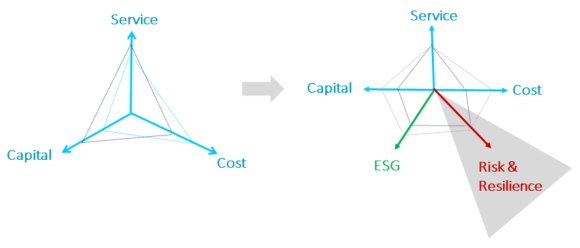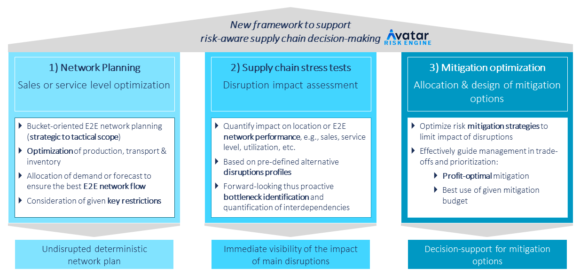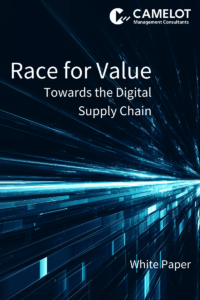The new highly disruptive external environment requires re-thinking how we design and manage supply chains. Especially now it is critical to avoid the traps of traditional supply chain risk management approaches and take a new perspective: stop chasing events, network risk modeling, systematic stress-testing, and clear quantification of risk impacts are prerequisites for moving to a new preventive risk management approach, which allows supply chain leaders to shape resilient supply networks instead of chasing one disruption after another.
In the last months, we have once again seen an accelerating increase of uncertainty and stress on global supply chains. Disruption is followed by disruption in an unprecedented way, causing shocks in supply as well as demand on many different levels. In this article, we will not spend time on describing this well-known situation, but rather focus on the most consequential strategic questions that need to be addressed in order to move forward:
- How can we structurally configure and parametrize our end-to-end supply networks to become more resilient, minimizing our vulnerability to disruptions?
- How can we effectively integrate risk in day-to-day supply chain decision making in the strategic, tactical, and operational horizon?
- As an enabler for both previous points, how can we quantify risk impact in an accurate and practical way, and effectively integrate it as a new target function and decision criterion for supply chain management?
While supply chain decision making in general has been well described and understood with regards to the key dimensions of service, cost, and capital, the question remains how we now can practically add risk and resilience (and we could similarly ask for ESG) to the equation. This is what we want to explore in this article.

Avoid Going Down the Rabbit Holes
It is often important to take a new perspective and think outside of the box, especially when faced with discontinuity in the external environment. In order to react to the new hyper-disruptive environment, companies need to consider changing perspective and especially avoid three common traps of supply chain risk management.
Do not think in risk events, focus on supply chain impact
It is very important to acknowledge that we are structurally unable to forecast disruptive events (unknown unknowns). Who forecasted the Eyjafjallajökull eruption, the lockdowns at the start of the pandemic, the developments in Ukraine, or the recent lockdowns in China? But still, companies often center their risk management around detecting and assessing potential risk events, which often proves a distraction and, in many cases, proves very hard to sustain. Instead, companies should rather decouple their thinking from discrete events, and focus on supply chain impact by working with event-neutral disruption profiles. For example, a 3-months, 100% output reduction at every supply node in the network could be a worst-case disruption profile to mitigate against, independent from the risk event which may cause it.
Do not over-engineer probabilities, quantify vulnerabilities
Probabilities for risk events (esp. the so-called unknown unknowns) are very difficult to derive in a fact-based way: What is the probability of a factory fire? Of a port shutdown? Of a pandemic lockdown? Trying to get probabilities right can often become a time-consuming trap for supply chain risk management. In order to derive the right mitigation actions, it is much more relevant to define the right range of disruption profiles (what supply chain impact to mitigate against, independent of events), and give them a reasonable weighting compared to an undisrupted base case, e.g., 80% (base case) to 20% (a full range of disruptions, e.g., equally weighted). This is fully sufficient to quantify the vulnerabilities in the network and identify the right actions.
Do not stress firefighting over structural preparedness
Supply chain managers are often excellent crisis managers and firefighters. Rolling up the sleeves and figuring out quick and practicable ways to keep the customers happy is a very important capability for companies. However, in today’s environment where shock waves hit higher and higher, it is critical to not only stress the art of crisis management, but also the science of structural preparedness. Without strong structures and prevention, short-term crisis management and firefighting may soon become futile. However, in the light of increasing uncertainty and limited resources for risk prevention, we need to move from judgement-based rule-of-thumb risk prevention (e.g., 6 months risk stock for top 10 ten critical components), to a more comprehensive and scientific approach. The scarce resources for risk prevention need to be wisely allocated across the end-to-end network, reflecting financial metrics, lead times and capacities, as well as network interdependencies and flexibility.
A Framework for Risk-Aware Supply Chain Decision Making
We propose a new framework for risk-aware decision-making that helps to address the strategic questions described above. It can support the pro-active assessment of the supply chain and prepare the network for the unexpected – ranging from unknown-unknowns and minor variabilities in demand and material costs to the consideration of undisrupted, thus normal operations. In order to provide this functionality, the framework is endowed with three major capabilities: network planning, supply chain stress-testing and mitigation optimization.

1) Network planning provides the undisrupted baseline for risk assessment
Before even thinking of disruption profiles and risk scenarios, we need a baseline network plan to compare disrupted scenarios with. This means
- setting up a digital model of the end-to-end network (at least with all internal and tier-1 external supply nodes),
- simulating how the forecasted demand of the next two to three years can be supplied, and
- which lost sales, margin, service levels will be achieved in a business-as-forecasted scenario.
This first step alone typically creates valuable insights into supply capabilities, network weak points, and value at risk. To provide a realistic picture, the (strategic to tactical) network planning capability optimally allocates demand or forecast over the end-to-end network, while respecting current production, transportation, and inventory restrictions.
2) Supply chain stress-testing evaluates the impact of disruption profiles
The future will most likely hold a range of disruptions. To prepare for these, one ideally describes these possible futures precisely not by tracking down risk events, but by understanding the supply chain and business impact, so-called disruptions scenarios. For example, a life science company decided to define a 100% capacity reduction starting from two weeks for a maximum of up to four months in every supply node of the network (incl. internal and external production, transportation lanes, and distribution centers) as the maximum range of disruptions, thus creating overall more than 2,000 disruption profiles. Based on these pre-defined profiles, the stress-test propagates the impact of disturbed supply chain processes across the end-to-end network down to the customers in all regions. It also quantifies the impact on performance measures such as (lost) sales, profit or service level, thus providing a very tangible and quantified measure of network vulnerability. To mirror reality in the best way, the quantification takes into account how the remaining, undisturbed network would optimally respond according to its capabilities. If, for example, a finished good production line A is considered as disrupted by the disruption profile, other finished goods production lines could take over parts of the demand previously allocated to production line A. In that sense, the stress-test is already the best-case outcome of a disruption.
3) Mitigation optimization designs and allocates mitigation options best suited to the quantified level of risk
Once we know about the degree of risk, the immediate need for countermeasures arises. The key objective is to identify the best mix of available preventative measures such as dual sourcing, additional transportation, balancing additional risk inventory and capacity that maximizes sales or service level even under harsh conditions. The result of this mitigation optimization can be a re-parametrization of network processes, e.g., increase inventory for finished good X by 20% at the EU warehouse and increase production capacity at production line A by 10% – to be further investigated if this is possible by increased shop floor efficiency. On the other hand, the result can also suggest a re-design of the network, e.g., increase production capacity at line A by 150%, which refers to the implementation of an additional production line and needs to be investigated on a more strategic basis. As there are countless options for mitigation along the end-to-end network and only limited resources or budget available, optimization models can add real value by determining the risk- and profit-optimal mix of different mitigation actions. Supply chain managers can thus answer questions like these step by step and help shaping the best de-risking strategy: “If we wanted to fully mitigate the risk scenarios, how much would we need to spend on inventory, capacity, or additional sources, or all combined? With a mitigation budget of 50 million EUR, where would risk prevention most pay off?”
Building New Capabilities and Processes for Structural Risk Preparedness
As client projects have shown, building new capabilities and processes is at the heart of this new supply chain risk management approach centered around structural risk preparedness. With regards to capabilities, risk management is an area which requires the effective combination of different skills, especially:
- end-to-end value chain and network management skills, esp. with regards to understanding business targets and priorities, as well as the ability to engage a cross-functional team in systematically reviewing and optimizing risk prevention measures and clearly communicate risk impacts and decision trade-offs to management
- quantitative decision support capabilities, with regards to discrete event simulation and linear, stochastic optimization of the best risk response strategy
- supply chain technology capabilities, with regards to data integration, rapid prototyping of digital twins and decision support tools, and back-integration with planning/ERP systems
But it does not stop here. Beyond providing the capabilities, companies need to integrate risk in key supply chain decision making processes, as for example:
- strategic network planning (e.g., 3-5 years out), which needs to include risk impact/vulnerability as a critical quantitative decision criterion besides service, unit cost, and CAPEX. One good example is the network resilience index, which measures the share of supply network nodes or even resources that is not impacted by disruptions or serves as a back-up source of flexibility.
- tactical supply planning and S&OP/IBP, which needs to ask the question “How does this supply chain decision change our risk profile?”. The traditional supply impact assessment of scenarios based on criteria such as revenue, margin, inventory, write-offs needs to be extended by quantitative measures of vulnerability to risk, such as expected lost sales.
- inventory management, which needs to integrate the checks and balances of risk analysis. While changes of the risk profile in net working capital optimization are often not clear and visible enough, the new risk approach can clearly show how inventory optimization will change the vulnerability of operations (e.g. as expected lost sales or margin).
In times of accelerating disruptions and uncertainty, it is mission-critical for supply chain leaders to challenge old ways of working and build a strong foundation for risk prevention and structural preparedness. Effectively bringing the tough choices of how to make the network and business more resilient to management will be THE most valuable business contribution of supply chain leaders now and in the years to come.
How do you integrate risk in supply chain decision making? Let us know your thoughts and questions.

